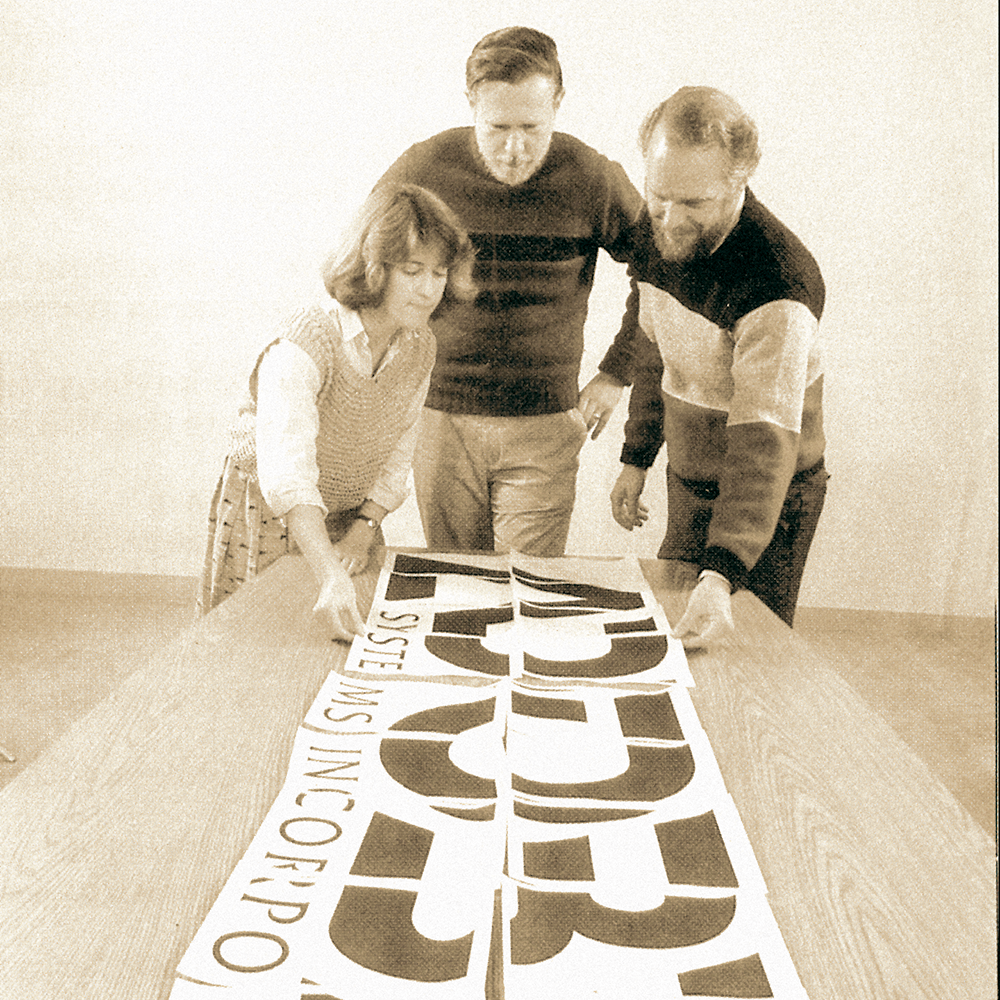
August 23, 2006
Helmut Krone, Period.
Print advertisement for Polaroid. Copy by William Casey, photograph by Bert Stern, art direction by Helmut Krone, Doyle Dane Bernbach, 1958
A strange gulf exists today between the worlds of design and advertising. That makes it easy to forget that one of the greatest designers that ever lived was an advertising art director: Doyle Dane Bernbach’s Helmut Krone.
Long before branding became a buzzword, Krone intuitively understood how graphic design could define an institution’s personality. “The page, ” he once said, “ought to be a package for the product. It should look like the product, smell like the product…Every company, every product, needs its own package.” Without ever designing a logo — often without even using a logo — he created corporate images that endure to this day. How many companies can be said to “own” a typeface the way that Volkswagen does Futura Bold? They have Helmut Krone to thank for that.
Finally, nearly ten years after his death, the man has received the treatment he deserves: a beautifully designed, relentlessly researched, and gracefully written volume by Clive Challis, Helmut Krone. The book. Graphic Design and Art Direction (concept, form and meaning) after advertising’s Creative Revolution. (Or via Amazon UK.) The title is long, but Challis backs up every word in the book’s 268 lavishly illustrated pages. It leaves me with no doubt that something I once suspected is, in fact, true: Helmut Krone is God.
Print advertisement for Volkswagen. Copy by Julian Koenig, art direction by Helmut Krone, Doyle Dane Bernbach, 1959
I sense that bit of hero worship would be scoffed at by many of those who knew Krone personally, which I never did. Another admirer, George Lois, once called him “a complex kraut” with a “dour, Buster Keaton face,” “a fidgety perfectionist who worked with deadly Teutonic patience.” And indeed, some of his simplest, clearest, most effortless-looking work was the product of brutal sweat.
Take, for instance, the tangled route to the legendary ad for VW that came to emblemize an entire decade’s worth of creative advertising. According to Challis’s book, Krone’s original headline was “Wilkommen.” The client rejected it — rightly so — and pulled “Think small” from the last line of Julian Koenig’s copy. Could that be the headline? “He hated it with a passion. With a passion!” remembered his then-colleague Lois, who was at DDB working on VW’s van account. “I suppose,” Krone asked (and you can sense the exasperation), “you want me to make the car small?” After some back-and-forth (Krone also tried making the headline itself small), the final layout was painstakingly created. Said Koenig: “A little car up in the upper left corner at a little angle — which was the peculiar genius of Helmut.”
It is hard to imagine today the impact that this kind of advertising had in the early sixties, where most cars still had big fins and most ads for them featured polo ponies and people in evening wear sipping champagne. The understatement, the conversational tone of voice, the utter lack of glamor all foretold a revolution in the making. Yet, typically, Krone’s revolutionary art direction was plunked securely on an absolutely conventional, even boring, layout, then called “old JWT No. 1” after the lumbering Madison Avenue standby J. Walter Thompson: two-thirds image above, centered headline, three columns of body copy below. No one knew like Krone did the power of taking the ordinary and making a subtle, transformative alteration. “There’s a German word for it,” he once said. “Umgekehrt — turned around slightly.” Krone built his reputation on thousands of such slight turns.
Print advertisement for Avis. Copy by Paula Green, art direction by Helmut Krone, Doyle Dane Bernbach, 1963
Challis’s book is filled with this kind of detail. Born in 1925 to immigrant parents in Yorkville, Manhattan’s German enclave, he attended the High School for Industrial Art, where he hoped to become a product designer. But exposure to the work of the city’s hottest young designer, Paul Rand, and the one of the country’s most acclaimed ones, Lester Beall, convinced the 18-year-old Krone that his future might lie with print. He followed naval service in WWII with postwar classes with Alexey Brodovitch and a stint at Esquire. Then, at the age of 29, he joined the best ad agency in town, Doyle Dane Bernbach, then a vertible murderers row of art directors, all championed by the groundbreaking genius Bill Bernbach. With the exception of a few years in the early seventies, he would spend his entire career there.
Krone was addicted to “zigging when everyone else was zagging.” His ads for Avis followed the triumph of VW, but neatly turned the JWT No. 1 formula on its head: little picture, big body copy, set in a fastidiously modified version of Eric Gill’s Perpetua Bold. “No one was using it,” Krone said. “I liked the fact that it was so unautomotive. Rather it was bookish, literate.” Krone wanted people to read the copy. Perpetua still figures in Avis’s promotional material 40 years later. Like with VW’s Futura, Krone made a choice, stuck with it, and made it stick.
And, in Avis’s case, without resorting to something he hated: a logo. “I’ve spent my whole life fighting logos,” he said when he was inducted to the Art Directors Club Hall of Fame. “Logos say ‘I am an ad. Turn the page.'” It was amazing how often he succeeded in vanquishing them, or better still, replacing them with something better. His famous series of “famous faces” for Polaroid, for instance, bore no corporate signature but rather a silhouetted image of someone experiencing that then-magical product in use. Towards the end of his book, Challis devotes a spread to counting off Krone’s breakthroughs. Ads with no headlines. Headlines as captions. Photographs as logo. Typeface as brand. No headlines or copy. No product, just a sea of white. The shock of the new, delivered in sharp, precise little doses.
Print advertisement for Audi. Photograph by Manny Gonzalez, art direction by Helmut Krone, Doyle Dane Bernbach, 1978
Print advertisement for Porsche. Copy by Tom Yobaggy, photograph by David Langley, art direction by Helmut Krone, Doyle Dane Bernbach, 1979
An attempt to start his own agency in the early seventies didn’t work; Krone seemed to enjoy not only the friction of straining against conventional advertising, but against the conventions of an established workplace. His work in the years following his return to DDB continued to startle. I remember one of my design professors bringing in one of his poetic magazine ads for the Audi Fox to us to admire: clearly, it was influenced by fashion advertising, but how daring to transpose that suggestive language to the world of cars. The same magazines would sometimes also feature Krone’s ads for Porsche. I was studying under Swiss-trained teachers, but Helvetica was never like this. “I wanted to make the entire page like the car, which is strictly Braun,” he later told U&lc. “I’m not into Swiss design. But I decided, for this, I have to be. So I brushed up on it…I used Swiss design principles, but because of its exhuberance I called it American Swiss.”
That combination of discipline and joy, of casual ease (to “brush up” on something we were spending five years studying!) and Teutonic precision: this is what makes Helmut Krone special. The most surprising discovery unearthed by Challis is his claim that Krone introduced into current practice a custom that, like some many other of his breakthroughs, we now take for granted: the use of a full stop, or period, after a headline. That period — “Think small.” — was the hallmark of DDB’s celebrated forthrightness. And more: “Putting a full point in a headline was an act of sedition,” writes Challis. “It broke the pace and invited inspection — maybe even circumspection — of the statement. Of course this is exactly why Krone used one: he had statements to make which he wanted to be examined.”
Let there be no doubt: these statements are still worth examining. And, with this book as a resounding full stop to an amazing body of work, Helmut Krone, indisputably, gets the last word.
Observed
View all
Observed
By Michael Bierut
Recent Posts
Shifting Narratives ft. Moya Bailey, IllumiNative’s Crystal Echo Hawk, & #JoyToThePollsEllen McGirt|Design and Climate Change
What will we do when all the levees break? The Halls and The Streets ft. Congresswoman Barbara Lee & One Fair Wage’s Saru Jayaraman How to pitch Design Observer


